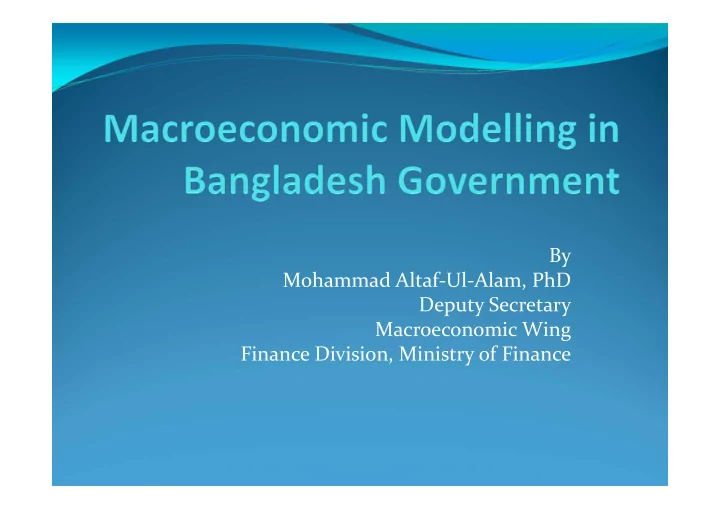

By Mohammad Altaf ‐ Ul ‐ Alam, PhD Deputy Secretary Macroeconomic Wing Finance Division, Ministry of Finance
Outline Institutional Framework for Macroeconomic Modelling Current Modelling/Forecasting framework Recent Forecasting Experiences Challenges and Difficulties faced by Policy Makers Advanced macroeconomic modelling initiative Comments
Institutional Framework By law, at least two meetings are held generally in every fiscal year presided over by the Minister, Ministry of Finance. Meeting is called ‘Coordination Council Meeting’ attended by Commerce Minister and around 10 secretaries of the ministries related to economics, finance and commerce.
Institutional Framework (Con’t) World economic situation, real sector, fiscal sector, monetary sector and external sector are discussed thoroughly in the meeting. Macroeconomic wing prepares the primary • forecasting scenario, then basically value judgemental and technical issues are addressed in the meeting and forecast of macroeconomic variables are finalized. A mid ‐ term (3 year) forecasting is finalized. Every • six months in the next meeting forecast are revisited and if necessary revised.
Bangladesh GDP Movement
Current Model Objective of the model is to do macroeconomic • analysis and forecasting. It is an excel based analysis, the model was • primarily taken from IMF then customized with the country perspective. Model includes four basic sectors of the economy • and their interlinkages. These are real, fiscal, monetary and external sectors.
Current Model Indicator Actual Actual Budget Projection Projection Projection 2013-14 2014-15 2015-16 2016-17 2017-18 2018-19 Bill Tk. Bill Tk. Bill Tk. Bill Tk. Bill Tk. Bill Tk. 13437 15136 17167 19500 22147 25186 Nominal GDP (bn Taka) Nominal Growth (%) 12.1 12.6 13.4 13.6 13.6 13.7 Nominal GDP (bn Dollar) 172.9 195.0 220.3 243.7 276.8 314.8 Nominal GNI (bn Dollar) 184.4 207.5 235.8 260.1 295.5 336.3 Net factor income (bn Dollar) 11.5 12.5 15.5 16.4 18.6 21.5 Real GDP Growth (%) 6.06 6.51 7.0 7.2 7.4 7.6 Deflator (% change) 5.7 5.8 6.1 6.1 5.9 5.9 Inflation (%) 7.4 6.5 6.2 6.0 5.8 5.7 Percapita GNI ( USD) 1184 1314 1474 1604 1798 2020
Procedure (1) There are 15 sectors in the economy to calculate GDP. Sectoral growth we put exogenously taking trend or moving average or sometime considering value judgment. GDP deflator 2016 = Actual GDP deflator 2015*(1+Forecasted growth of deflator in 2016 i.e. Inflation) Real GDP 2016= Actual Real GDP 2015*(1+Forecasted GDP growth rates) Nominal GDP 2016= Real GDP 2016* deflator 2016 GDP growth rate are forecasted based on trend analysis and value judgement
Procedure (2) Basically using some simple procedure we put values of exogenous variables in the model. Fiscal expenditures are like policy variables so we put exogenously. For revenue income we have assumptions on different tax/GDP ratios basicaly based on elasticities. Lot of such procedures we follow for other variables.
Recent Initiative We are now trying to develop a macroeconometric forecasting model. It is based on econometric analysis Calculations are done in Eviews At present the model is very simple model. We shall extend it further.
Data and Methodology Data range is 1981 to 2014 Data are low frequency data ‐ annual. Data sources are Bangladesh Bureau of Statistics, Ministry of Finance and Bangladesh Bank. At present it is a macroeconometric model (Error Correction Model). Only demand side equations are considered in the model due to data unavailability of supply side variables.
Model Equations Private Consumption Long ‐ run equation log pc con log yd dum t t Short ‐ run equation d log pc con d log yd dum ecm _ pc ( 1 ) t t Private Investment Long ‐ run equation 1 log pinv con log pinv log tradeopen t t t Short ‐ run equation d log pinv con d log pinv log tradeopen ecm _ pinv t t 1 t t 1
Model Equations (2) Exports Long ‐ run equation log exp con worldGDP price exp dum t t t Short ‐ run equation d log exp con d log worldGDP price exp dum ecm _ exp t t t t 1 Import Long ‐ run equation log imp con log GNI price _ imp t t t Short ‐ run equation d log imp con d log GNI d log price _ imp ecm _ imp t t t 1
Model Equation(3) Identity GDP pc pinv pub _ con pub _ inv exp imp discrepanc y t t t t t t t t Endogenous Variables GDP, Private Consumption, Private Investment, Export and Import Exogenous Variables All other variables in those equations Then model is solved in E ‐ views with dynamic solution. The model shows different growth rates than our Medium term outlook. It is respectively 6.7, 7.2 ,6.7 and 7.2 percent in 2016, 2017,2018 and 2019.
Comments Forecasting process is not yet highly technical. We need a better model for the management of macroeconomic and financial indicators. Sustainable development goals are not yet integrated in our macroeconometric forecasting model. In fact we came here to learn that.
Recommend
More recommend